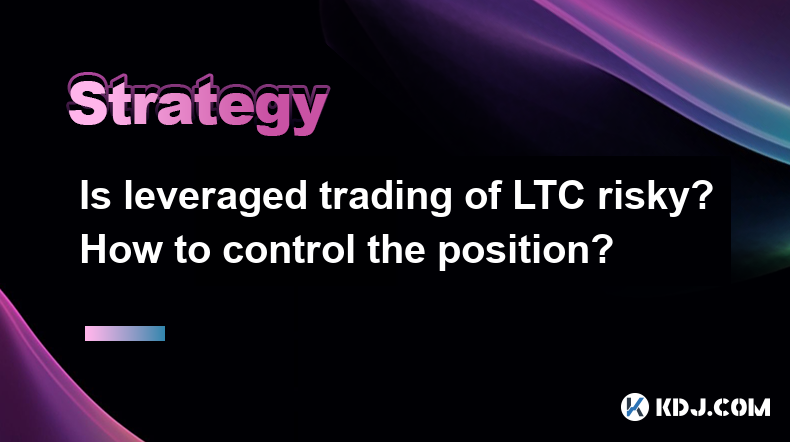-
 bitcoin
bitcoin $114684.631706 USD
-0.87% -
 ethereum
ethereum $4228.677447 USD
1.58% -
 bnb
bnb $1294.880693 USD
-1.16% -
 tether
tether $1.000819 USD
-0.02% -
 xrp
xrp $2.605138 USD
2.79% -
 solana
solana $209.908690 USD
5.89% -
 usd-coin
usd-coin $0.999903 USD
-0.03% -
 dogecoin
dogecoin $0.213423 USD
2.93% -
 tron
tron $0.322721 USD
-0.10% -
 cardano
cardano $0.727247 USD
3.66% -
 hyperliquid
hyperliquid $42.339456 USD
6.05% -
 chainlink
chainlink $19.910811 USD
5.16% -
 ethena-usde
ethena-usde $1.000557 USD
0.00% -
 stellar
stellar $0.349734 USD
2.69% -
 bitcoin-cash
bitcoin-cash $543.848687 USD
-0.21%
Is leveraged trading of LTC risky? How to control the position?
Leveraged trading of LTC is risky due to market volatility; control positions with stop-loss orders, take-profit orders, and careful leverage management.
May 02, 2025 at 01:43 pm

Is leveraged trading of LTC risky? How to control the position?
Leveraged trading of Litecoin (LTC) can indeed be risky, but with proper strategies and risk management, it is possible to control your position effectively. Leveraged trading allows traders to open positions larger than their initial investment, amplifying both potential gains and losses. Understanding the risks and learning how to manage your positions is crucial for anyone looking to engage in this type of trading.
Understanding Leveraged Trading and Its Risks
Leveraged trading involves borrowing funds from a broker to increase the size of a trading position. For example, with a 10x leverage, a trader can control a position worth 10 times their initial capital. While this can lead to significant profits, it also means that losses can be equally magnified. If the market moves against your position, you could lose more than your initial investment.
The primary risk in leveraged trading of LTC is market volatility. Cryptocurrencies like Litecoin are known for their price swings, which can be both an opportunity and a danger. A sudden drop in LTC's price can lead to a margin call, where the broker demands additional funds to keep the position open. If you cannot meet the margin call, your position may be liquidated at a loss.
Setting Up a Leveraged Trading Account
To start leveraged trading of LTC, you need to set up an account with a broker that offers cryptocurrency trading with leverage. Here are the steps to follow:
- Choose a reputable broker: Look for brokers that are well-regulated and have a good reputation in the crypto trading community.
- Sign up and verify your account: Complete the registration process and go through the necessary identity verification steps.
- Deposit funds: Add money to your account, keeping in mind the minimum deposit requirements for trading with leverage.
- Understand the leverage options: Familiarize yourself with the different leverage ratios offered by the broker, such as 2x, 5x, 10x, or even higher.
Once your account is set up, you can start trading LTC with leverage. It's essential to understand the broker's margin requirements and the potential for margin calls before you begin.
Strategies for Controlling Your Position
Effective position control in leveraged trading involves several key strategies:
- Set stop-loss orders: A stop-loss order is an order placed with a broker to sell a security when it reaches a certain price. This helps limit potential losses by automatically closing your position if the market moves against you.
- Use take-profit orders: A take-profit order is similar to a stop-loss order but is used to lock in profits. Set a take-profit order at a price level where you are satisfied with the gains.
- Monitor your positions closely: Given the volatility of LTC, it's crucial to keep an eye on your positions. Use trading platforms that offer real-time data and alerts to stay informed.
- Manage your leverage: Start with lower leverage ratios until you gain more experience. Higher leverage increases risk, so it's wise to use it cautiously.
Risk Management Techniques
Risk management is vital in leveraged trading. Here are some techniques to help you manage risks effectively:
- Diversify your portfolio: Don't put all your funds into one position. Spread your investments across different assets to reduce the impact of a single loss.
- Calculate your risk-reward ratio: Before entering a trade, assess the potential reward against the potential risk. A favorable risk-reward ratio can help you make more informed trading decisions.
- Keep an emergency fund: Set aside a portion of your capital as an emergency fund to cover potential margin calls or unexpected market movements.
- Educate yourself: Continuously learn about the market, trading strategies, and new tools that can help you make better trading decisions.
Tools and Platforms for Leveraged Trading
Several platforms offer leveraged trading of LTC. Some of the most popular ones include:
- Binance: Known for its wide range of trading pairs and high liquidity, Binance offers leveraged trading with up to 125x leverage on some futures contracts.
- BitMEX: A pioneer in crypto derivatives, BitMEX offers high leverage up to 100x on LTC perpetual contracts.
- Kraken: A well-regulated exchange, Kraken provides leveraged trading with up to 5x leverage on LTC.
When choosing a platform, consider factors such as fees, user interface, security features, and the level of leverage offered. Each platform has its own set of tools and features that can help you manage your positions more effectively.
Practical Example of Position Control
Let's walk through a practical example of how to control a leveraged position in LTC. Suppose you have $1,000 in your trading account and decide to use 5x leverage to buy LTC. This means you can control a position worth $5,000.
- Open the position: You buy LTC at $100 per coin, so your position is 50 LTC ($5,000 / $100).
- Set a stop-loss order: To limit your potential loss, you set a stop-loss order at $90 per LTC. If the price drops to $90, your position will be automatically closed, limiting your loss to $500 (50 LTC * ($100 - $90)).
- Set a take-profit order: To lock in profits, you set a take-profit order at $110 per LTC. If the price reaches $110, your position will be closed, and you will make a profit of $500 (50 LTC * ($110 - $100)).
- Monitor the position: Keep an eye on the market and adjust your stop-loss and take-profit orders if necessary. If LTC's price starts to move favorably, you might want to move your stop-loss order higher to protect more of your gains.
By following these steps, you can effectively control your leveraged position in LTC and manage the associated risks.
Frequently Asked Questions
Q: What is the difference between margin trading and leveraged trading?A: Margin trading and leveraged trading are often used interchangeably, but there is a subtle difference. Margin trading refers to the practice of borrowing funds from a broker to trade larger positions, while leveraged trading specifically refers to the use of leverage to amplify the potential returns on an investment. In essence, leveraged trading is a type of margin trading.
Q: Can I lose more than my initial investment in leveraged trading?A: Yes, it is possible to lose more than your initial investment in leveraged trading. If the market moves against your position and you cannot meet a margin call, your position may be liquidated at a loss greater than your initial investment. This is why risk management is crucial in leveraged trading.
Q: How do I choose the right leverage ratio for trading LTC?A: Choosing the right leverage ratio depends on your risk tolerance, trading experience, and market conditions. Beginners should start with lower leverage ratios, such as 2x or 5x, to minimize risk. More experienced traders might opt for higher leverage, but they should always be aware of the increased risk. It's important to assess your comfort level with potential losses and adjust your leverage accordingly.
Q: Are there any specific indicators I should use for leveraged trading of LTC?A: While there are no specific indicators designed solely for leveraged trading, some commonly used indicators for trading LTC include the Relative Strength Index (RSI), Moving Averages, and Bollinger Bands. These indicators can help you identify potential entry and exit points and manage your positions more effectively. Always combine technical analysis with a solid risk management strategy.
Disclaimer:info@kdj.com
The information provided is not trading advice. kdj.com does not assume any responsibility for any investments made based on the information provided in this article. Cryptocurrencies are highly volatile and it is highly recommended that you invest with caution after thorough research!
If you believe that the content used on this website infringes your copyright, please contact us immediately (info@kdj.com) and we will delete it promptly.
- XRP Price Prediction: Weekend Rollercoaster or Rally?
- 2025-10-12 08:45:16
- Bittensor (TAO): Super Bullish Signals Point to Potential 2x Rally
- 2025-10-11 10:25:12
- Silver Price Correction: Navigating the Dip & Identifying Key SEO Keywords
- 2025-10-11 10:25:12
- Decoding Crypto Trends: Bittensor's Bull Run, Cardano's Dip, and LivLive's Presale Buzz in 'Uptober 2025'
- 2025-10-12 08:45:16
- MoonBull: The Crypto Meme Coin Promising 1000x Gains?
- 2025-10-11 10:30:01
- Crypto Payroll Revolution: Stablecoins, Altcoins, and the Future of Salary Payments
- 2025-10-11 10:30:01
Related knowledge

Practical parameter settings for a Bitcoin multi-timeframe moving average system
Sep 18,2025 at 10:54pm
Optimizing Timeframe Combinations for Bitcoin Trading1. Selecting appropriate timeframes is crucial when building a multi-timeframe moving average sys...

How can I filter out false breakouts in Dogecoin high-frequency trading?
Sep 22,2025 at 01:00am
Understanding False Breakouts in Dogecoin Trading1. A false breakout occurs when Dogecoin's price appears to move beyond a defined support or resistan...

Techniques for identifying tops and bottoms in the Bitcoin on-chain NVT model
Sep 20,2025 at 07:54pm
Understanding the NVT Model in Bitcoin Analysis1. The Network Value to Transactions (NVT) ratio is often described as the 'P/E ratio' of the cryptocur...

What does the surge in open interest in Bitcoincoin futures mean?
Sep 20,2025 at 11:18pm
Understanding the Surge in Dogecoin Futures Open Interest1. A surge in open interest within Dogecoin futures indicates a growing number of active cont...

How can I use the Ethereum USDT premium to gauge market sentiment?
Sep 18,2025 at 11:55pm
Understanding the Ethereum USDT Premium1. The Ethereum USDT premium refers to the price difference between USDT (Tether) traded on Ethereum-based plat...

What should I do if Ethereum staking yields decline?
Sep 20,2025 at 06:18am
Understanding the Causes Behind Declining Ethereum Staking Yields1. The Ethereum network transitioned to a proof-of-stake consensus mechanism with the...

Practical parameter settings for a Bitcoin multi-timeframe moving average system
Sep 18,2025 at 10:54pm
Optimizing Timeframe Combinations for Bitcoin Trading1. Selecting appropriate timeframes is crucial when building a multi-timeframe moving average sys...

How can I filter out false breakouts in Dogecoin high-frequency trading?
Sep 22,2025 at 01:00am
Understanding False Breakouts in Dogecoin Trading1. A false breakout occurs when Dogecoin's price appears to move beyond a defined support or resistan...

Techniques for identifying tops and bottoms in the Bitcoin on-chain NVT model
Sep 20,2025 at 07:54pm
Understanding the NVT Model in Bitcoin Analysis1. The Network Value to Transactions (NVT) ratio is often described as the 'P/E ratio' of the cryptocur...

What does the surge in open interest in Bitcoincoin futures mean?
Sep 20,2025 at 11:18pm
Understanding the Surge in Dogecoin Futures Open Interest1. A surge in open interest within Dogecoin futures indicates a growing number of active cont...

How can I use the Ethereum USDT premium to gauge market sentiment?
Sep 18,2025 at 11:55pm
Understanding the Ethereum USDT Premium1. The Ethereum USDT premium refers to the price difference between USDT (Tether) traded on Ethereum-based plat...

What should I do if Ethereum staking yields decline?
Sep 20,2025 at 06:18am
Understanding the Causes Behind Declining Ethereum Staking Yields1. The Ethereum network transitioned to a proof-of-stake consensus mechanism with the...
See all articles










































































